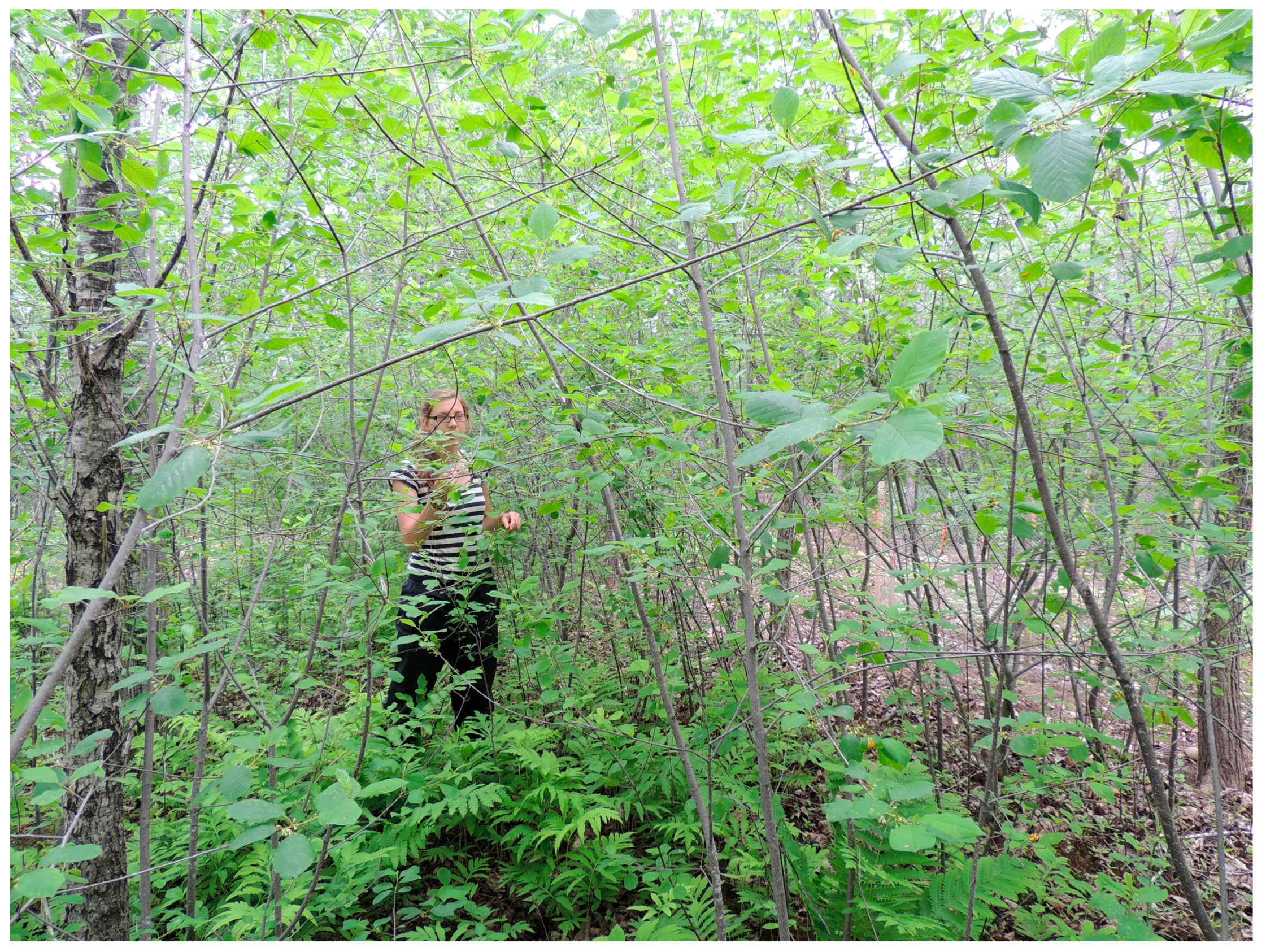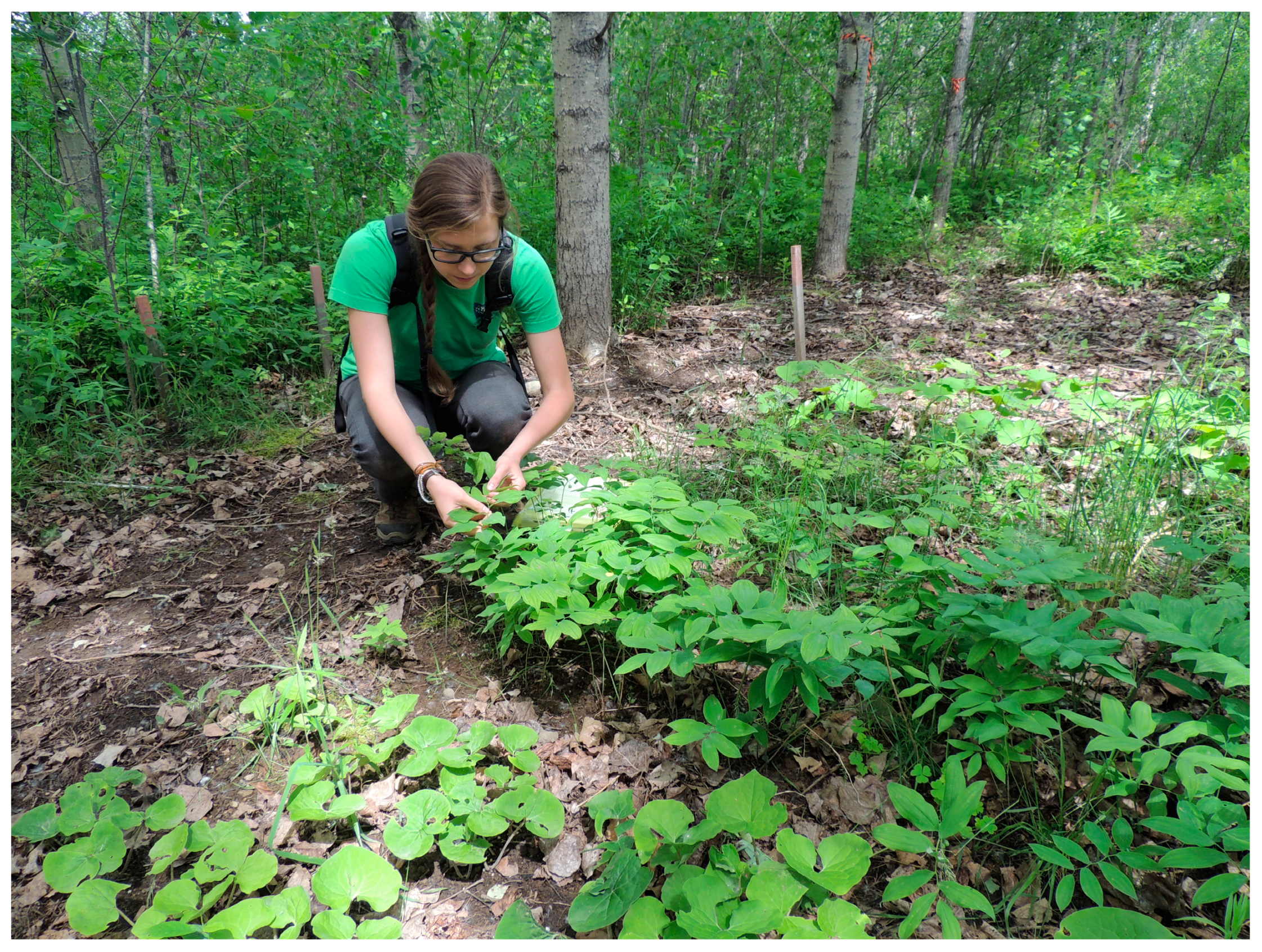Exotic Invasive Shrub Glossy Buckthorn Reduces Restoration Potential for Native Forest Herbs
Abstract
:1. Introduction
2. Materials and Methods
2.1. Study Site
2.2. Transplantation of Forest Herbaceous Plants
2.3. Measurements of Transplanted Forest Herbs
2.4. Forest Herbs Allometric Relationships
2.5. Measurement of Environmental Variables
3. Results
3.1. Results of the Forest Herb Experiment
3.2. Environmental Variations between Clone Types and between Treatments
4. Discussion
5. Conclusions
Acknowledgments
Author Contributions
Conflicts of Interest
References
- Lavoie, C.; Saint-Louis, A.; Guay, G.; Groeneveld, E. Les plantes vasculaires exotiques naturalisées: Une nouvelle liste pour le Québec. Le Nat. Can. 2012, 136, 6–32. [Google Scholar] [CrossRef]
- Mills, J.E.; Reinartz, J.A.; Meyer, G.A.; Young, E.B. Exotic shrub invasion in an undisturbed wetland has little community-level effect over a 15-year period. Biol. Invasions 2009, 11, 1803–1820. [Google Scholar] [CrossRef]
- Stohlgren, T.J.; Jarnevich, C.; Chong, G.W.; Evangelista, P.H. Scale and plant invasions: A theory of biotic acceptance. Preslia 2006, 78, 405–426. [Google Scholar]
- Gordon, D.R. Effects of invasive, non-indigenous plant species on ecosystem processes: Lessons from Florida. Ecol. Appl. 1998, 8, 975–989. [Google Scholar] [CrossRef]
- Mack, R.N.; Simberloff, D.; Lonsdale, W.M.; Evans, H.; Clout, M.; Bazzaz, F.A. Biotic invasions: Causes, epidemiology, global consequences, and control. Ecol. Appl. 2000, 10, 689–710. [Google Scholar] [CrossRef]
- Ricciardi, A.; Cohen, J. The invasiveness of an introduced species does not predict its impact. Biol. Invasions 2007, 9, 309–315. [Google Scholar] [CrossRef]
- Macdougall, A.S.; Turkington, R. Are invasive species the drivers or passengers of change in degraded ecosystems? Ecology 2005, 86, 42–55. [Google Scholar] [CrossRef]
- Westman, W.E. Park management of exotic plant species: Problems and issues. Conserv. Biol. 1990, 4, 251–260. [Google Scholar] [CrossRef]
- Macdonald, I.A.W.; Loope, L.L.; Usher, M.B.; Hamann, O. Wildlife conservation and the invasion of nature reserves by introduced species: A global perspective. In Biological Invasions: A Global Perspective; Drake, J.A., Ed.; John Wiley Sons Ltd.: New York, NY, USA, 1989; pp. 215–255. [Google Scholar]
- Converse, C.K. Element Stewardship Abstract for Rhamnus Cathartica and Rhamnus Frangula (syn. Frangula alnus); The Nature Conservancy: Arlington, VA, USA, 1984. [Google Scholar]
- Frappier, B.; Eckert, R.T.; Lee, T.D. Experimental removal of the non-indigenous shrub Rhamnus frangula (glossy buckthorn): Effects on native herbs and woody seedlings. Northeast. Nat. 2004, 11, 333–342. [Google Scholar] [CrossRef]
- Nagel, L.M.; Corace, R.G., III; Storer, A.J. An experimental approach to testing the efficacy of management treatments for glossy buckthorn at Seney National Wildlife Refuge, Upper Michigan. Ecol. Restor. 2008, 26, 136–142. [Google Scholar] [CrossRef]
- Fagan, M.E.; Peart, D.R. Impact of the invasive shrub glossy buckthorn (Rhamnus frangula L.) on juvenile recruitment by canopy trees. For. Ecol. Manag. 2004, 194, 95–107. [Google Scholar] [CrossRef]
- Possessky, S.L.; Williams, C.E.; Moriarity, W.J. Glossy buckthorn, Rhamnus frangula L.: A threat to riparian plant communities of the northern Allegheny Plateau (USA). Nat. Areas J. 2000, 20, 290–292. [Google Scholar]
- Mason, T.J.; French, K.; Lonsdale, W.M. Do graminoid and woody invaders have different effects on native plant functional groups? J. Appl. Ecol. 2009, 46, 426–433. [Google Scholar] [CrossRef]
- Catling, P.M.; Porebski, Z.S. The history of invasion and current status of glossy buckthorn, Rhamnus frangula, in southern Ontario. Can. Field Nat. 1994, 108, 305–310. [Google Scholar]
- Gagnon, D.; Bouchard, A. La vegetation de l’escarpement d’Eardley, parc de la Gatineau, Québec. Can. J. Bot. 1981, 59, 2667–2691. [Google Scholar] [CrossRef]
- Flinn, K.M.; Vellend, M. Recovery of forest plant communities in post-agricultural landscapes. Front. Ecol. Environ. 2005, 3, 243–250. [Google Scholar] [CrossRef]
- Nantel, P.; Gagnon, D.; Nault, A. Population viability analysis of American ginseng and wild leek harvested in stochastic environments. Conserv. Biol. 1996, 10, 608–621. [Google Scholar] [CrossRef]
- MDEL (Ministère du Développement Durable, de L’environnement et de la Lutte Contre les Changements Climatiques). Espèces Menacées ou Vulnérables au Québec. 2014. Available online: http://www.mddelcc.gouv.qc.ca/biodiversite/especes/ (accessed on 16 December 2014). [Google Scholar]
- Naud, J.; Olivier, A.; Bélanger, A.; Lapointe, L. Medicinal understory herbaceous species cultivated under different light and soil conditions in maple forests in southern Québec, Canada. Agrofor. Syst. 2010, 79, 303–326. [Google Scholar] [CrossRef]
- Boothroyd-Roberts, K.; Gagnon, D.; Truax, B. Can hybrid poplar plantations accelerate the restoration of forest understory attributes on abandoned fields? For. Ecol. Manag. 2013, 287, 77–89. [Google Scholar] [CrossRef]
- Boothroyd-Roberts, K.; Gagnon, D.; Truax, B. Hybrid poplar plantations are suitable habitat for reintroduced forest herbs with conservation status. SpringerPlus 2013, 2, 507. [Google Scholar] [CrossRef] [PubMed]
- Frappier, B.; Eckert, R.T.; Lee, T.D. Potential impacts of the invasive exotic shrub Rhamnus frangula L. (glossy buckthorn) on forests of southern New Hampshire. Northeast. Nat. 2003, 10, 277–296. [Google Scholar] [CrossRef]
- Owen Koning, C.; Singleton, R. Effects of moderate densities of glossy buckthorn on forested plant communities in southwest New Hampshire, USA. Nat. Areas J. 2013, 33, 256–262. [Google Scholar] [CrossRef]
- Baeten, L.; Hermy, M.; Verheyen, K. Environmental limitation contributes to the differential colonization capacity of two forest herbs. J. Veg. Sci. 2009, 20, 209–223. [Google Scholar] [CrossRef]
- Hamelin, C.; Truax, B.; Gagnon, D. Invasive glossy buckthorn impedes growth of red oak and sugar maple under-planted in a mature hybrid poplar plantation. New For. 2016, 47, 897–911. [Google Scholar] [CrossRef]
- Truax, B.; Gagnon, D.; Fortier, J.; Lambert, F. Yield in 8 year-old hybrid poplar plantations on abandoned farmland along climatic and soil fertility gradients. For. Ecol. Manag. 2012, 267, 228–239. [Google Scholar] [CrossRef]
- Drayton, B.; Primack, R.B. Rates of success in the reintroduction by four methods of several perennial plant species in Eastern Massachussets. Rhodora 2000, 102, 299–331. [Google Scholar]
- Petersen, R.G. Design and Analysis of Experiments; Marcel Dekker Inc.: New York, NY, USA, 1985. [Google Scholar]
- Hunt, R. Basic Growth Analysis. Plant Growh Analysis for Beginners; Unwin Hyman Inc.: Boston, MA, USA, 1990. [Google Scholar]
- R Core Team. R: A Language and Environment for Statistical Computing; R Foundation for Statistical Computing: Vienna, Austria, 2014; Available online: http://www.R-project.org/ (accessed on 15 December 2015).
- Hamelin, C.; Gagnon, D.; Truax, B. Aboveground biomass of glossy buckthorn is similar in open and understory environments but architectural strategy differs. Forests 2015, 6, 1083–1093. [Google Scholar] [CrossRef]
- Truax, B.; Gagnon, D.; Fortier, J.; Lambert, F. Biomass and volume yield in mature hybrid poplar plantations on temperate abandoned farmland. Forests 2014, 5, 3107–3130. [Google Scholar] [CrossRef]
- Drayton, B.; Primack, R.B. Success rates for reintroductions of eight perennial plant species after 15 years. Restor. Ecol. 2012, 20, 299–303. [Google Scholar] [CrossRef]
- Murphy, S.D. Concurrent management of an exotic species and initial restoration efforts in forests. Restor. Ecol. 2005, 13, 584–593. [Google Scholar] [CrossRef]
- Vance, E.; Loehle, C.; Wigley, T.; Weatherford, P. Scientific basis for sustainable management of Eucalyptus and Populus as short-rotation woody crops in the U.S. Forests 2014, 5, 901–918. [Google Scholar] [CrossRef]
- Fortier, J.; Truax, B.; Gagnon, D.; Lambert, F. Biomass carbon, nitrogen and phosphorus stocks in hybrid poplar buffers, herbaceous buffers and natural woodlots in the riparian zone on agricultural land. J. Environ. Manag. 2015, 154, 333–345. [Google Scholar] [CrossRef] [PubMed]
- Mottl, L.M.; Mabry, C.M.; Farrar, D.R. Seven-year survival of perennial herbaceous transplants in temperate woodland restoration. Restor. Ecol. 2006, 14, 330–338. [Google Scholar] [CrossRef]
- Heithaus, E.R. Seed predation by rodents on three ant-dispersed plants. Ecology 1981, 62, 136–145. [Google Scholar] [CrossRef]


| Species | Size Variable | Plants/Ramets Harvested (n) | Model x = Size Measurement (cm) Y = Dry Biomass (g) | R2 |
|---|---|---|---|---|
| Asarum canadense (biomass of part of a ramet) | Leaf width (cm) | 76 | Y = 0.0236x1.3282 | 0.80 |
| Sanguinaria canadensis (biomass of part of a ramet) | Leaf width (cm) | 25 | Y = 0.01819x1.7095 | 0.88 |
| Polygonatum pubescens (biomass of one plant) | Stem length, first to last leaf (cm) | 56 | Y = 0.1181x1.1091 | 0.77 |
| SAC | ASC | POP | Treatment Mean | Treatment Standard Error | Treatment p Value | |
|---|---|---|---|---|---|---|
| Herbicide | 66% | 48% | 33% | 49% | 15% | 0.097 |
| Control | 79% | −35% | −33% | 4% | ||
| Species mean | 72% | 6% | 0% | |||
| Species standard error | 19% | |||||
| Species p value | 0.029 * |
| Variable | Clone Types | Treatments | ||
|---|---|---|---|---|
| F | p Value | F | p Value | |
| Glossy buckthorn | ||||
| Stem density | 0.93 | 0.437 | 31.68 | <0.001 *** |
| Seedling density | 0.38 | 0.600 | 1.46 | 0.294 |
| Total aboveground biomass | 1.91 | 0.301 | 9.64 | 0.0361 * |
| Soil nutrients | ||||
| NO3 | 1.67 | 0.325 | 0.00 | 0.978 |
| P | 0.67 | 0.500 | 0.57 | 0.493 |
| K | 1.35 | 0.365 | 0.62 | 0.475 |
| Ca | 0.37 | 0.607 | 0.02 | 0.905 |
| Mg | 0.46 | 0.566 | 1.45 | 0.295 |
| Soil humidity | 1.49 | 0.347 | 0.24 | 0.651 |
| Canopy openness | ||||
| 1 m aboveground | 26.05 | 0.0363 * | 0.35 | 0.584 |
| 3 m aboveground | 1.09 | 0.405 | 0.72 | 0.445 |
| Understory vegetation biomass (without buckthorn) | 0.51 | 0.549 | 16.5 | 0.0154 * |
| Hybrid poplar | ||||
| Volume | 3.17 | 0.217 | ||
| Biomass | 7.89 | 0.107 | ||
| Variable | Unit | Herbicide | Control | Standard Error | p Value |
|---|---|---|---|---|---|
| Glossy buckthorn | |||||
| Stem density | n/m2 | 0 | 4 | 1 | 0.0049 ** |
| Seedling density | n/m2 | 66 | 127 | 36 | 0.294 |
| Total aboveground biomass | g/m2 | 2 | 503 | 114 | 0.0361 * |
| Soil humidity | % | 20 | 20 | 1 | 0.651 |
| Canopy openness | |||||
| 1 m aboveground | % | 31 | 32 | 1 | 0.584 |
| Understory vegetation biomass (without buckthorn) | g/m2 | 6 | 68 | 11 | 0.0154 * |
© 2017 by the authors. Licensee MDPI, Basel, Switzerland. This article is an open access article distributed under the terms and conditions of the Creative Commons Attribution (CC BY) license ( http://creativecommons.org/licenses/by/4.0/).
Share and Cite
Hamelin, C.; Gagnon, D.; Truax, B. Exotic Invasive Shrub Glossy Buckthorn Reduces Restoration Potential for Native Forest Herbs. Sustainability 2017, 9, 249. https://doi.org/10.3390/su9020249
Hamelin C, Gagnon D, Truax B. Exotic Invasive Shrub Glossy Buckthorn Reduces Restoration Potential for Native Forest Herbs. Sustainability. 2017; 9(2):249. https://doi.org/10.3390/su9020249
Chicago/Turabian StyleHamelin, Caroline, Daniel Gagnon, and Benoit Truax. 2017. "Exotic Invasive Shrub Glossy Buckthorn Reduces Restoration Potential for Native Forest Herbs" Sustainability 9, no. 2: 249. https://doi.org/10.3390/su9020249
APA StyleHamelin, C., Gagnon, D., & Truax, B. (2017). Exotic Invasive Shrub Glossy Buckthorn Reduces Restoration Potential for Native Forest Herbs. Sustainability, 9(2), 249. https://doi.org/10.3390/su9020249




